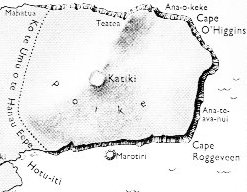|
TAHUA
27 No description of the Tahua text can ignore the text on the Small Washington Tablet (R). Because there are evidently parallel sections between A and R. This does not mean that these texts have been constructed by the same writer, nor that they were intended to convey the same messages. However, I suggest the structures were by way of oral traditions bound to be parallel - as far as this is possible because the A text is much longer. Or one could say that the 'melody' was the same and that this melody could accompany different song texts, and also be played on different instruments.
Below we can see that the 3 glyphs which in the A text presumably are beginning with a 'zero' day preceding April 28 (118 → 4 * 29½ and 42 * 8 = 336 = 12 * 28) are similar to three R glyphs which I once upon a long time ago have arranged to be presented in parallel:
There is a similarity between the pair of contrasting G and K texts on one hand and on the other hand the pair of contrasting A and R texts:
The contrasts between the glyphs in A and R are very eye-catching, for instance:
To my mind comes the important Easter Island myth describing the fate of Hanau Eepe. Hanau. 1. Race, ethnic group. Hanau eepe, the thick-set race; hanau momoko, the slender race (these terms were mistranslated as 'long-ears' and 'short-ears'). 2. To be born. Hanau tama, pregnant woman; vī'e hanau poki, midwive (also: vī'e hakaa'u). Vanaga. To be born; vie hanau, midwife. P Pau.: fanauga, child, descendant, progeny. Mgv.: hanau, to be born, to be brought into the world. Mq.: fanau, hanau, to be born, to lie in, to bring into the world. Ta.: fanau, to be born, to lie in. Churchill. ... 'Watch my house. Watch it for the sign that I shall give. On the day after tomorrow the Long-ears are to light the oven for your corpses. Form yourselves into a line, make everybody join in, come there, make a circle round the Long-ears, round their land of Poike. Start killing them. Throw them into the pit, change that oven to your own and cook the Long-ears for yourselves.' Before the dawn that woman went back to her house at Potu te rangi. She said to her people, 'Be quick and do.' Then she went to her house and stayed there, plaiting a basket in the doorway. She was plaiting a basket with her eyes on the Long-ear men. They were filling their oven with firewood. When it was sunset the Short-ears gathered. It was already dark; they gathered, they came; the first men hid in the house of the woman who was plaiting the basket. The rest concealed themselves behind, they formed a line, they waited. The woman who was plaiting told them where the Long-ears were. They were in their houses. Therefore the Short-ears went around Kikiriroa and Mount Teatea. They drew up all in order, they marched in the night, they came down to the point of Mahatua. They remained there, they slept, they hid themselves. And at the first light all those Short-ears rose up, they rushed out with their spears and surprised the Long-ear people, they were all still resting in their houses. They rushed and chased, those Short-ear men, they chased the Long-ears out. They made them all run to the ditch which they had dug themselves. They lit the fires. ... ... It should be stated right now that 'fire' is actually a great circle reaching from the North Pole of the celestial sphere to its South Pole ...
|
||||||||||||||||||||||||||||||||||||||||||||||||||||||||||||||||||||||||||||||||||||||
.jpg)




